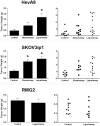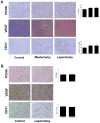Surgical stress promotes tumor growth in ovarian carcinoma
- PMID: 19351748
- PMCID: PMC2746852
- DOI: 10.1158/1078-0432.CCR-08-2966
Surgical stress promotes tumor growth in ovarian carcinoma
Abstract
Purpose: Surgical stress has been suggested to facilitate the growth of preexisting micrometastases as well as small residual tumor postoperatively. The purpose of this study was to examine the effects of surgical stress on ovarian cancer growth and to determine underlying mechanisms responsible for increased growth.
Experimental design: To mimic the effects of surgery, we did a laparotomy or mastectomy under isoflurane inhalation on athymic nude mice 4 days after i.p. tumor cell injection. Propranolol infusion via Alzet pumps was used to block the influence of sympathetic nervous system activation by surgical stress.
Results: In both HeyA8 and SKOV3ip1 models, the mice in the laparotomy and mastectomy groups had significantly greater tumor weight (P < 0.05) and nodules (P < 0.05) compared with anesthesia only controls. There was no increase in tumor weight following surgery in the beta-adrenergic receptor-negative RMG-II model. Propranolol completely blocked the effects of surgical stress on tumor growth, indicating a critical role for beta-adrenergic receptor signaling in mediating the effects of surgical stress on tumor growth. In the HeyA8 and SKOV3ip1 models, surgery significantly increased microvessel density (CD31) and vascular endothelial growth factor expression, which were blocked by propranolol treatment.
Conclusion: These results indicate that surgical stress could enhance tumor growth and angiogenesis, and beta-blockade might be effective in preventing such effects.
Figures





References
-
- Weese JL, Ottery FD, Emoto SE. Do operations facilitate tumor growth? An experimental model in rats. Surgery. 1986;100:273–7. - PubMed
-
- Eggermont AM, Steller EP, Marquet RL, Jeekel J, Sugarbaker PH. Local regional promotion of tumor growth after abdominal surgery is dominant over immunotherapy with interleukin-2 and lymphokine activated killer cells. Cancer detection and prevention. 1988;12:421–9. - PubMed
-
- Wildbrett P, Oh A, Carter JJ, et al. Increased rates of pulmonary metastases following sham laparotomy compared to CO2 pneumoperitoneum and the inhibition of metastases utilizing perioperative immunomodulation and a tumor vaccine. Surgical endoscopy. 2002;16:1162–9. - PubMed
-
- Lee SW, Gleason N, Blanco I, Asi ZK, Whelan RL. Higher colon cancer tumor proliferative index and lower tumor cell death rate in mice undergoing laparotomy versus insufflation. Surgical endoscopy. 2002;16:36–9. - PubMed
-
- Da Costa ML, Redmond P, Bouchier-Hayes DJ. The effect of laparotomy and laparoscopy on the establishment of spontaneous tumor metastases. Surgery. 1998;124:516–25. - PubMed
Publication types
MeSH terms
Substances
Grants and funding
LinkOut - more resources
Full Text Sources
Medical

